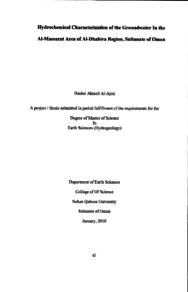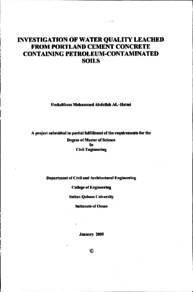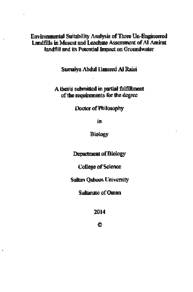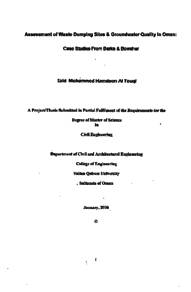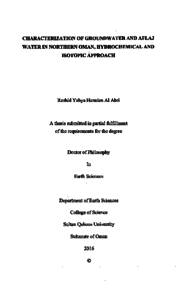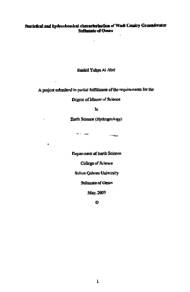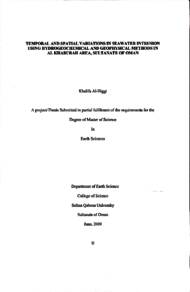Document
Hydrochemical characterization of the groundwater In the Al-Massarat Area of Al-Dhahira Region, Sultanate of Oman.
Publisher
Sultan Qaboos University
Gregorian
2010
Language
English
English abstract
Wadi Al-Ayn and Wadi Bu' Kraba wellfields comprise the main groundwater system in Al-Dhahira region in the Sultanate of Oman. The first drilling activities in the area commenced in 1960s by Petroleum Development of Oman (PDO) to supply water for injection of the oilfields. The springs and the shallow hand dug wells are the principal water resources in the study area which are used to irrigate many small farms scattered along the active wadies. These farms since then are extensively expanded beside the population growth due to urbanization was increased in the area and hence the water demands were increased and the seasonal rainfall was decreased.
The shortage of water resources in the arid and semi-arid regions which characterizes the study area and the increases in demand put the area under water shortage stress. For that reason Wadi Al-Ayn and Wadi Bu'Kraba wellfields were constructed after drilling of several observation wells in the Fars formations which later called AlMassarat Formations (MacDonald, 2003). This formation consists of dolomatic limestone and cemented conglomerates that formed in the Tertiary geological time. The quantity and quality deterioration of the groundwater result from the increased in groundwater demands as a result of the progressing development of the area and the extensive usage of fertilizers by many farms as well as the unlined septic tanks of the expanding urbanization. For these reasons, 110 groundwater samples were collected from different part of the Wadi Al-Ayn and Wadi Dank catchments and from all groundwater sources (monitoring boreholes, dug wells, gold mine wells and springs) available in the area.
The laboratory analyses done to find the major cations (Na, K, Ca, Mg) and trace elements by using Inductively Coupled Plasma of Atomic Emission Spectroscopy (ICP-AES). The anions (CI, HCO,, CO3, S04, F, NO3, NO2) were measured by using lon Chromatography Technique whereas the iron and manganese were measured by Atomic Absorption Spectroscopy apparatus. Groundwater hardness was measured by titration method of Radiometer. The determination of cyanide was done
of aqueous cyanide using a revised by Spectrophotometric determination phenolphthalin method.
The hydrochemical analysis results illustrate five hydrochemical facies (groups) distributing in the study area. The Piper trilinear diagram interpretation shows (SO4Cl-Ca-Mg-HCO3), (Cl-Na-SO4-HCO3-Ca), (Na-Cl-S04), (Na-Cl-SO4-HCO3) and (HCO3-Cl-SO4-Na-Ca-Mg) facies. The groundwater samples were shown excessive cations and anions concentrations which were above the drinking water standards. The groundwater hardness for the study area shows that the majority of water is hard to very hard water which indicates dissolutions of calcite and dolomite minerals (CaCO3 and CaMgCO3). The high level of nitrate indicates pollution occurrence for the groundwater by septic tanks and agricultural fertilizers. The cyanide analysis illustrates that the collected groundwater samples from around the gold mining factory and the tailing dams, were below the detection limits (0.005 mg/l).
Member of
Resource URL
Category
Theses and Dissertations

